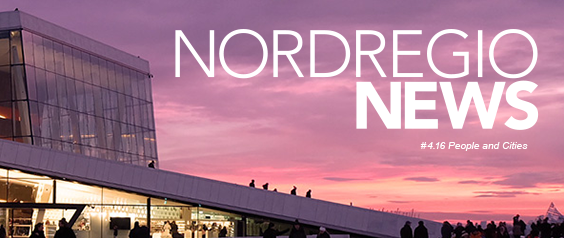Färgfabriken is an interesting space for exploring new forms of inclusive urban governance and new ways of thinking about participation in urban planning and development. It describes itself “as a platform for contemporary cultural expressions, with an emphasis on art, architecture and urban planning”. Through artistic and cultural expressions, events and exhibitions Färgfabriken raises many questions regarding participation in urban planning and development. And it actually provokes fundamental epistemological questions for both researchers and planners alike. What is legitimate (planning) knowledge and how knowledge is produced?
Färgfabriken wants to push the boundaries of what an exhibition space can be both metaphorically and literary, says Jan Rydén, independent artist and co-curator of the exhibition Experiment Stockholm that took place in Färgfabriken during the fall of 2015.
We sit in the old paint factory, which is the main exhibition space of Färgfabriken, and talk about our shared – but somewhat different – experiences of the exhibition Experiment Stockholm. Nordregio followed the work with the exhibition within the CASUAL research project, and contributed to events within it. Färgfabriken was a local partner in the research project involved already in the application phase but Experiment Stockholm was also the study object through which we investigated alternative forms of inclusive urban governance and the concept of urban living labs.
My conversation with Jan starts with a discussion on Färgfabriken’s general engagement in urban planning and development, its function as an arena for participation, but it ends up with a critical reflection on art, different forms of knowledge and epistemology.
Färgfabriken wants to be an independent intellectual voice, both inside and outside the mainstream urban planning debate, says Jan, and continues; perhaps we are considered a bit naïve by some, but we want to critically question the taken-for-granted, and our way of doing that is to experiment with different forms of artistic expressions and perspectives. Similar to universities and research institutes we strive to contribute with knowledge but with a different kind of knowledge that is not only logical and rational but also involves all senses and bodily experiences. We claim our right to participate in the debate about the future city as any other private stakeholder or organisation. Jan continues to explain that they do this through their own initiatives which are often based on the intersection between current concerns in society and previous projects.
As researchers we have followed the exhibition from 2012 when the initial ideas was formulated (and we wrote the application for the CASUAL project), via the preparatory activities and the setting up of the exhibition during 2014-2015, to the opening in September 2015 and the closing in late November the same year. During this period we as researchers participated in a selection of seminars and workshops and tried to find a logical process and analytical path-way through the exhibition project. We were particularly focused on if, and how, the exhibition and the space could be understood as an urban living lab. In what sense did it allow for experimentation, exploration, co-creation and evaluation? Reflecting on the outcomes and outputs of the CASUAL project Jan Rydén is a critical on what he sees as a narrow mindedness of the research project:
You researchers focused only on a limited number of activities, and thus you missed perhaps the more creative and innovative dimensions of the exhibition, that included participants beyond the ‘usual suspects’. There were a number of public activities around the art installations such as; bicycle dérive across the Southern suburbs of Stockholm, Luis Berriós- Negrón, the (literally) in-house resident in the Earthscore Specularium organised a number of open lunch seminars, and public debate was also organised on the floating ecological culture house Maretopia. Many school classes also visited the exhibition and there were activities on other places in the Stockholm region organised within the frame of Experiment Stockholm.
Article continues below


